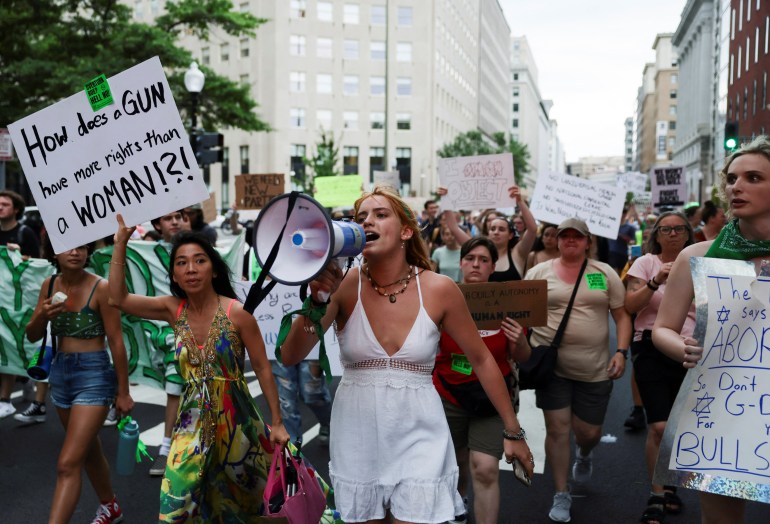What will US abortion sanctuary networks look like?
Volunteers, lawyers and non-profits are creating sanctuary networks for people seeking abortions in the United States.

Los Angeles, California, US – It was 1969 and Sunny Chapman, then 19, needed an abortion.
It was four years before Roe v Wade would enshrine abortion as a constitutional right in the United States, and Chapman had heard about the Jane Collective, a feminist network that provided underground abortions in Chicago.
Keep reading
list of 3 itemsThe US abortion fight, from the front line
Abortion misinformation in the United States of America
“I called Jane,” she said. “You know you’re in good hands, you know you’re going to be OK. But it’s still terrifying.”
A woman called back to vet her, and then connected her with a nearby counsellor, who scheduled the procedure. “They told me to stand on a particular corner wearing a particular colour sweater, which I think was yellow, and a car would pick me up,” Chapman said.
The car drove her to an apartment on the city’s south side. Then she was blindfolded and seated with other women in a van that took them to a house where a doctor would perform the procedure.
“I was further along than I knew, and the doctor didn’t want to do it because I was in the second trimester,” she told Al Jazeera. “I was crying and begging him.” Two Janes in the room with her convinced the doctor to complete the procedure. “It was unbelievably painful,” she recalled. “They dropped me off on my corner, and I was fine.”
In June, the US Supreme Court overturned Roe v Wade, allowing states to set their own abortion laws. As a result, 26 — about half of all US states — are likely to outlaw or restrict abortion in the coming weeks and months, according to the Guttmacher Institute, a reproductive rights advocacy group.
In response, volunteers, lawmakers, lawyers and activists are creating pathways similar to what the Jane Collective did in the 1960s. Already, dozens of abortion funds exist across the country, and states are passing bills to add more sanctuary networks.
“They just need us to be ready to help them,” said Chapman, who told Al Jazeera she is thinking of ways to aid the many support groups that are springing into action. “They need funding, and they’ll get it – because we’re all mad.”
Modern abortion networks
Since the Supreme Court’s ruling came down last month, the Facebook group Auntie Network USA said it has already received requests for help from pregnant people in Oklahoma, where abortions are now outlawed.
Three years ago, Lisa, based in Texas, and Vlada, in Oregon, started the nationwide network in which volunteer “aunties” help “nieces” who are in need of abortions. The co-founders requested that only their first names be published because they have faced threats.
“You have a lot of unstable people in the world who think it’s their mission to target us,” Lisa told Al Jazeera. Under Texas law, she also runs the risk of being sued for helping people access abortions. “It doesn’t bother me,” she said.
Last fall, Texas banned abortions performed after a fetal heartbeat is detected, at about six weeks of pregnancy, making abortion inaccessible for most pregnant people living in the state. “Once Texas practically outlawed abortion last September, we became very busy,” Lisa said.
Lisa and Vlada do not perform abortions themselves, but the network helps with logistical and financial support — finding people rides to their appointments or a safe place to recover.
Things are very different today compared with when Chapman had her abortion, they said. Vlada explained that the digital landscape brings “a big advantage”; their public-facing Facebook group draws people into the community, while organisers mostly communicate with “nieces” through encrypted channels.
Chapman’s abortion also was a “dilation and curettage” procedure that involved dilating the cervix and scraping the uterine lining with a spoon-shaped instrument. Today, pregnant people can take a combination of pills early in pregnancy to safely induce a miscarriage. The pills can be prescribed via telehealth and sent by mail. “Those kits are absolutely critical to modern abortion care,” Lisa said, referring to abortion pills.
Lisa and Vlada believe groups like theirs are the future of abortion in the US. “We have developed a system that works, and it’s safe,” Lisa said.
Legislative efforts
As of July 8, at least 10 states have banned abortion following the Roe v Wade ruling, according to a tally by The New York Times, with more expected to follow. Republican states are also seeking to block sanctuary networks’ efforts. Some, such as South Dakota, are threatening to ban abortion pills sent by mail, although it is unclear how the state would enforce such a measure.
And while it is currently legal for people to cross state lines to access abortion, President Joe Biden predicted this month that police in some Republican states will arrest those who do. Biden on Friday signed an executive order that he said would help protect access to abortion, including through out-of-state travel.
Against this backdrop, California, New York and other states with Democratic governors are racing to pass new bills that will do the opposite and bolster access to abortion, including by establishing government-funded abortion networks.

In New York, a team of lawyers drafted the Santoro Act, which they hope can be a template for other states, creating a national abortion sanctuary network. If passed, it would create a nonprofit corporation within the New York Department of Health with at least $15m in grant funding for people who need abortions. The nonprofit would also accept private donations, according to Jim Walden, managing partner at Walden, Macht & Haran and one of those at the firm who drafted the legislation.
The network would advertise services in states where abortions are unavailable, Walden told Al Jazeera. Anyone in need of an abortion can fill out an application, and intake staff will call them to assess their needs. The fund would dole out grants to cover travel or abortion pills. The bill also restricts the sanctuary state from sharing personal information with the state in which abortion is inaccessible.
But with so many states passing legislation, and with many nonprofits and organisations already funding abortions, Walden acknowledged that the landscape is crowded: “They all have great ideas … but it almost seems like it’s competitive,” he said.
In May, New York assemblyman Charles Lavine proposed the Santoro Act, but it has not yet passed. Walden said they plan to reintroduce the bill during the next legislative session. He also called for solidarity among abortion sanctuary networks, pointing out that Roe was overturned because anti-abortion rights activists had a unified action plan. “We’re not going to be able to counteract that unless everyone can pull together around some central principles,” he said.
Equitable access
Meanwhile, reproductive rights advocates are organising abortion networks not only across state lines, but also within states where it is legal.
Callers to the Access Reproductive Justice helpline can speak to someone in Spanish or English. The non-profit abortion fund based in California helps people both in- and out-of-state. The fund will assess their needs, triage them, and book an appointment for a medical or surgical abortion at a clinic. The group also provides funding for hotels, food and child care, if needed. Volunteers, who have been thoroughly vetted, provide rides and emotional support.
“Most people who call our line are just barely making ends meet,” said Tricia Gray, volunteer engagement coordinator at Access Reproductive Justice.
Gray emphasised that, even in states where abortion is legal, people face barriers including lack of funds, long distances to the nearest clinic, and transphobia. “What we’re trying to do is move beyond Roe v Wade because that was the floor, if you will, in terms of just making it legal,” she said. “That didn’t mean that people had equitable access.”
While many abortion advocates feel despair, Gray finds hope in the civil rights movement; it showed her that marginalised groups can come together to create change. “We are connected to 90 other networks in the country,” she said.
“We are doing this as a group. None of us are doing this alone.”
After her procedure in the 1960s, Chapman said, “I got my life back.”
Despite experiencing an underground abortion, which she knows was risky, Chapman said, “Today, it’s way, way more dangerous and scary.” She pointed to recent violence against pro-abortion rights protesters, and said the Jane Collective did not have to worry about mass shootings and automatic weapons. “You didn’t have to deal with this crazy violence then.”
She knows she is part of a movement that will do whatever it takes to help pregnant people get the care they need. “I’ll donate money, I’ll do whatever I can do to help women get abortions, and there are millions of women like me across the country,” she said.
“I’ve fought this battle before and I’ll do it again.”